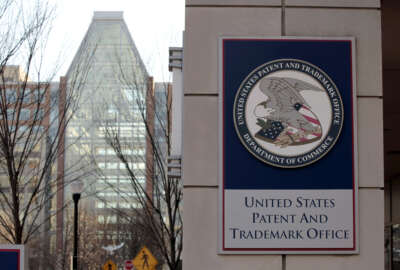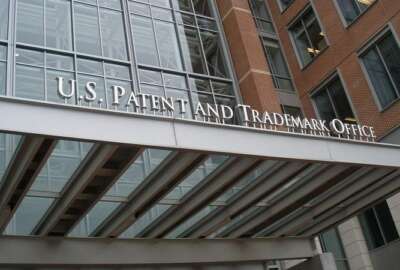

Two former U.S. Patent and Trademark Office directors — one from the Obama administration and one from the Trump administration — recently formed a coalitio...
Best listening experience is on Chrome, Firefox or Safari. Subscribe to Federal Drive’s daily audio interviews on Apple Podcasts or PodcastOne.
Two former U.S. Patent and Trademark Office directors — one from the Obama administration and one from the Trump administration — recently formed a coalition. Its aim is to protect U.S. intellectual property, particularly from theft by China. They’ve got ideas for what Congress ought to do. Federal Drive host Tom Temin talked with the one of the co-chairmen of the Council for Innovation Promotion and former USPTO director Andrei Iancu.
Interview transcript:
Tom Temin: And we should point out David Kappos, who was your predecessor under the Obama administration is your co-chair in this effort, but you’re calling it the Council for Innovation Promotion, rather than innovation protection. So why that title?
Andrei Iancu: Well, those two things are very much related. Obviously, the main goal is economic growth in the United States through innovation. So the main goal is to promote innovation and to grow innovation in the United States. Obviously, protecting intellectual property is a tool in that effort. It is, in our view, the most critically important, necessary tool. But nevertheless, it’s just one tool, other factors would go into promoting innovation other than IP, but IP is critically important to the ultimate goal, which is the grow American based innovation.
Tom Temin: And you mentioned two facts in some of the write ups. One is that China is leading the United States in the sheer number of patents it files for some of the critical technologies like artificial intelligence, quantum, and so on. And at the same time, it is stealing intellectual property from the United States. On that latter point, what is their mechanism, simply seeing what we file for patents, ignoring the patents, taking the art and just using it without paying people fees? Or is it more like a cyber theft into the intellectual property that is maybe not patented, but under development by U.S. corporations, or maybe a little of both?
Andrei Iancu: The theft is prolific, Tom, and there are multiple mechanisms. One example mechanism is through the forced transfer of technology, from American companies doing business in China, forcing companies to partner with Chinese based companies through which IP is appropriated by state owned enterprises, their variety of other examples, purely copying American IP, and then not having a robust enforcement mechanism within China for American companies to be able to defend their IP. Finally, to the vast economy of counterfeit goods, more than 80% of counterfeit goods in the international trade channels come from China and its territories. And the Chinese government is doing very little, if anything, to stop it, or to reduce it. And this is ongoing, and has been ongoing for a good number of years. And all of these activities absolutely have to stop.
Tom Temin: So it’s really also a trademark as well as a patent issue.
Andrei Iancu: Absolutely, very much. So it’s all of IP, but definitely very much patents and trademarks at the forefront.
Tom Temin: And just briefly review the system internationally of patents because there is cross I guess, recognition of patent systems between the United States and other nations like us, Japan honors U.S. patents, and vice versa. I think there’s about half a dozen nations that interoperate, where does China fit into that whole picture?
Andrei Iancu: Actually, Tom patents are territorial. So an American patent is defensible only in the United States, a Japanese patent only in Japan and so on. And you know, for an American company, for example, that wants to protect its patented technology in the United States, it needs to get an American patent, if at the same time wants to protect its patent in Japan, it should get the Japanese patent. Same thing applies to China. So if it wants to protect its IP, its patents in China, it needs to apply for and get a Chinese patent. But then, of course, in all of these jurisdictions, there have to be robust mechanisms for enforcing those patents issued by those specific governments. You know, the vast majority of the world has a robust transparent enforcement system like the United States, Japan, South Korea, all the European countries and so on. In China, it’s different. It’s not all that transparent. It’s not uniformly robust. And these are issues that need to be worked on.
Tom Temin: All right, we’re speaking with Andrei Iancu, former director of the U.S. Patent and Trademark Office and now co-chairman of the newly formed Council for Innovation Promotion. You’ve got a prescription that maybe we can get at this as a country through some congressional action. What are your recommendations? I guess we’re talking about the 118th Congress now, which is already got lots on his plate.
Andrei Iancu: Yes. Although I have to tell you, Tom, that when there’s lots of division in Congress, and nobody can agree on anything, sometimes they agree on IP, which is a good thing. It’s a bipartisan issue. And if they need to get something done, sometimes they reach into IP. So I am hopeful that progress can be made in the next Congress. Look, we have to recognize that China has a two pronged approach to technological dominance into this and next centuries. So first is the stealing of IP, as we have discussed, which has to stop. But at the same time, we must recognize that the Chinese are actually inventing at faster and faster rates. And that is their original innovation. We know that technologies they’re investing in, because they tell us, and they’re made in China 2025, 2030 plans and beyond. And it’s not just China, a lot of other countries are innovating, and competing for a piece of the technological pie for the technologies of the Fourth Industrial Revolution, like AI, like quantum and so on.
The United States, if we want to maintain our technological edge, we must double down and compete at the same time; we have to very much increase our innovation multiple fold. And to that end, we need to think about what are all the factors that go into increasing innovation, and we need to address them in a systematic manner. None of it can happen without first strengthening our IP system. If there is a member of Congress that goes around and says that they are for innovation, they must automatically be for a robust intellectual property system, you simply cannot maintain that you are for American innovation, and at the same time, vote for bills that weaken the American intellectual property ecosystem. Those two things are highly interrelated, and one cannot go without the other. So at the very minimum, we have to maintain a strong IP system here. How do we do that? There are a lot of factors that go into that calculus. There are a number of bills that need to be pushed through an example is a bill that Sen. Tillis (R-N.C.) introduced in the last Congress, I suspect he’ll introduce it again in this Congress, Sen. Coons (D-Del.) said that he was co-sponsor it, as well. So it’s nice to see bipartisanship. And it deals with what’s called patentable subject matter, what types of innovations are subject to the patent system in the first place. This area of law needs significant clarification. And it’s good to see that some senators are taking a leading role in addressing that issue.
Tom Temin: Got it. And so as you point out, this is bipartisan. So there is a good chance. I’m surprised that the areas of development that are subject to patent law are unclear at this point, 200 years into this experiment.
Andrei Iancu: Yes, indeed. So and you’re not the only one that is surprised when America has the first modern democratic patent system in the world. And here we are, a couple centuries later, where we have sort of lost focus on this fundamental issue. What’s happened, Tom, is that in the past couple of decades, the Supreme Court issued a number of decisions on this threshold question, what is subject to patent and what isn’t subject to patent? I’ll give you an example. Diagnostic techniques, we’re very familiar with this issue, because of the recent COVID pandemic, diagnostic tests, you know, where you swab and you decide, you know, the test tells you whether you do or you don’t have COVID. That’s a diagnostic test. Based on the recent Supreme Court jurisprudence, diagnostic tests are not subject to the patent system in the United States. It’s absolutely remarkable. But that is the status quo. And it’s the result of the confusion created by recent Supreme Court cases, as interpreted by the lower courts. In the years since. That issue has to be clarified by Congress,
Tom Temin: We were talking about updating the types of intellectual property that could be considered patentable, and from what you said things like methods as well as technologies or new chemicals or new medicines themselves, methodologies in variety of domains then would be necessary.
Andrei Iancu: Yeah, absolutely. So you know, obviously, drugs, pills, treatments, those are available for patent. But the method of detecting a disease currently is not patentable in the United States. It’s not the only thing as a result of the recent Supreme Court case law. For example, it’s very unclear if certain forms of computer software are subjected to patents, for example, issues dealing with cybersecurity or cryptography, for example, that are heavily based on mathematical calculations. Not so clear from patent to patent from technology to technology ahead of time, if you know you invest money in this area, you will develop a new technology file for a patent, not so clear if the courts would enforce that patent down the line. That’s another example that needs to be clarified. Because the technologies of the future very much depend on these methodologies. Think about artificial intelligence, autonomous vehicles. A lot of this new technology depends on heavy mathematical calculations and algorithms. There has to be a way to be able to determine and clearly whether your investment will be protected or not.
Tom Temin: Yeah, that’s interesting on the software, one that has some historical precedent because I think it was the IBM company, way, way back in the 1960s that argued against patents for software, because they wanted their machines to sell. And they would give me with the software that came with the machine. That all reversed at some point. And I’m surprised that argument is still going on.
Andrei Iancu: It is, you know, Tom software is it’s a funny type of technology, because it’s not perfectly clear which area of IP it fits in, is it really subject to copyright, and it is, in some circumstances, is a subject of patents. And it is in some circumstances, but it’s never been made crystal clear, what is the best and most clear approach for protecting software. The reason for this, and not to get too philosophical in our short time together here, but the reason for this is that software by itself, actually doesn’t do anything. Right. Patents usually are for things that do stuff, you know, in the old days, they used to call them the useful arts, making things work, products, machines, processes, and so on. Software needs to be combined with a computer, obviously, to start doing stuff. And that’s what’s leading to this somewhat confusing area of law, because on its own is just zeros and ones, either on a piece of paper or residing in some sort of a machine without doing much of anything.
Tom Temin: I guess you could say the same thing about chemical compounds. They’re just combinations of carbon, oxygen and hydrogen atoms in different sulfur atoms. But yet, they don’t do anything to add water or add them to gasoline, or add them to some other process to cause a catalytic change. So yes, we are on fuzzy ground there, I guess you might say.
Andrei Iancu: Yeah, absolutely. And by the way, if this radio thing doesn’t work out, you’re welcome to the patent profession, because you seem to be putting your finger right on the crux of the issue. You know, what’s happening is, chemical compounds or many other things that if you just leave them alone, don’t do anything. They are things that you can touch, there are things that you can see their physical, and courts and legislators forever, human beings forever have been used to tangible products and technologies, software, you can’t see, you know, it is intangible, it’s transient, to some extent. And I feel that, to a large extent, is my personal view, the courts and others have had a tough time grappling with it, because it is the ultimate form of intangible intellectual development. Now, you’re right, ultimately, it’s the same thing ultimately, is human made. And it’s done for a purpose to do something. And, you know, once it operates on a computer, it absolutely does something very important, even if you cannot see it, even if you cannot touch it. And my personal view is that obviously needs to be protected. But this needs to be clarified. And the rules of the game have to be made crystal clear. So that inventors and investors have some predictability, that what they will be doing will be protectable and under what parameters.
Tom Temin: We’re speaking with Andrei Iancu, former director of the U.S. Patent and Trademark Office, and now co-chairman of the newly formed council for innovation promotion. Yes, it goes, you can see where software again to pull on that thread a little further underlies so many of the advances, let’s take hypersonics for instance, we’ve been able to move things hypersonicly for decades, going back to the 50s. The difference is maybe making them aimable. Making them do things that they could not do mostly is a result of some kind of a software process that in turn affects the mechanical process.
Andrei Iancu: Absolutely. Those are good examples and more think about autonomous vehicles, the self-driving software that enables vehicles to drive those are definitely you know, it’s it’s computer code. It’s not tangible, not visible, that’s making a very visible, very tangible machine actually do something. And I can’t emphasize enough how important resolving this issue is. Because the technologies of the future depend on this stuff, artificial intelligence, quantum computing, and the like. You can’t you know, cryptography, cybersecurity, you can’t do any of these things without heavy investment in brand new innovation that’s backed by intellectual property because otherwise, who in a free market economy is going to invest the huge amounts of money that’s necessary in risky technologies that are failure prone, you don’t know if it’s going to work at the end of the day, but if they do work, they’re easily replicable. And, you know, if you don’t have robust IP protection in a free market economy, investors will not choose to put their hard-earned dollars into these areas. And we as a nation are going to be left behind because primarily our Imperator is a centralized economy, a centralized dictatorship that can tell its companies what to do where to invest its money. We don’t have that luxury. We don’t want it. We want our free market system. But we need to have something to incentivize and protect those investments. And the only way to do it reliably is through intellectual property protection.
Tom Temin: And the final question, you have created a new council, the Council for Innovation Promotion in Washington, who are your backers? I mean, who’s behind this, since it is sounding like a very bipartisan effort with you and David Kappos, and there’s a couple of lawyers from both sides that are involved with your counsel. Who your backers?
Andrei Iancu: Well, first of all, it is bipartisan and on the board, that’s myself and Dave Kappos as well as two federal judges, one appointed by a Republican and other by a Democrat, the member role is confidential so we can’t disclose it. But the idea here, Tom, is to impress upon our legislators and decision makers and the public that you simply cannot have innovation in the United States at the scale we have been used to without a robust IP system. The two are inextricably linked. And that’s the main goal of this council.
Copyright © 2024 Federal News Network. All rights reserved. This website is not intended for users located within the European Economic Area.
Tom Temin is host of the Federal Drive and has been providing insight on federal technology and management issues for more than 30 years.
Follow @tteminWFED



